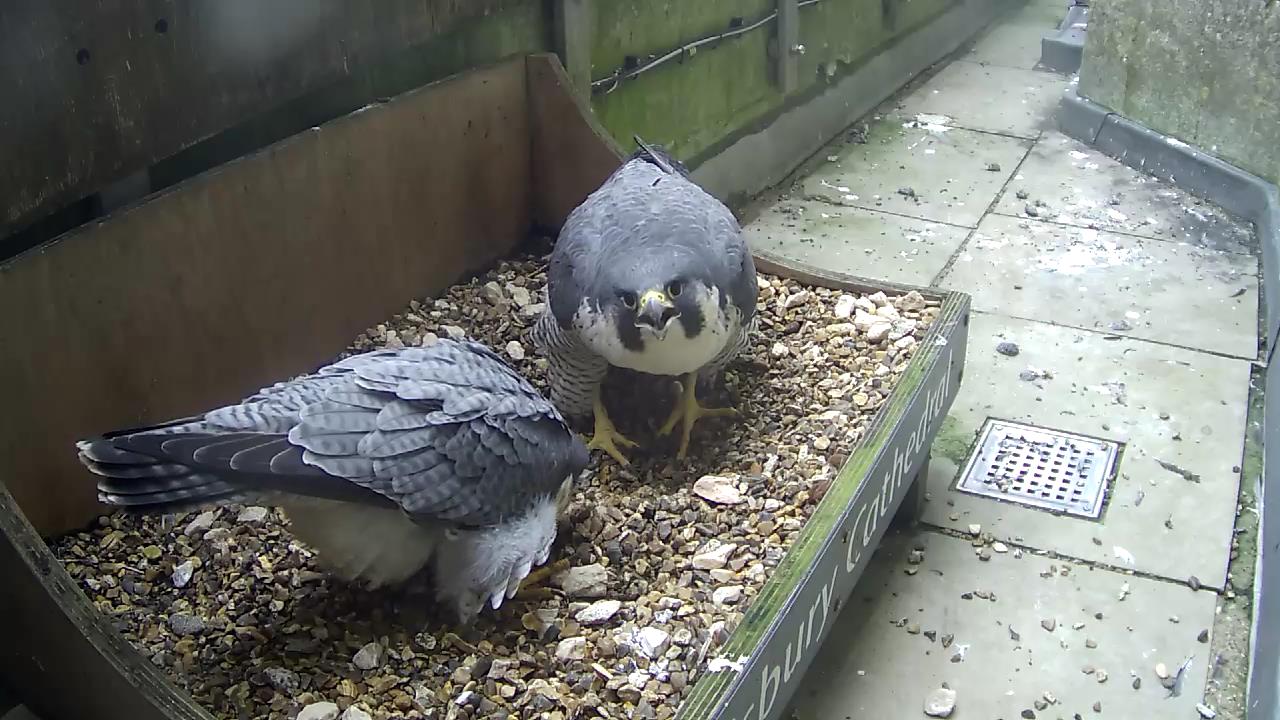Peregrine Falcon Blog 2023 No 1.

I seem to start my annual blogs every year with something along the lines of ‘how time flies by’; it seems hardy any time at all that I started my sequence of last year’s blogs in March 2022. So what to say that I have not said before? Well, both of our resident birds are unringed, so we have no idea where they were born or indeed whether they are the same two birds which bred last year or indeed as long ago as 2019. With the big increase in recent years of birds breeding in urban location on manmade structures, there has been a consequential increase of the number of chicks being ringed in such locations. Ringed birds are usually given a small aluminium and numbered British Trust for Ornithology (BTO) ring, plus a larger and colour coded Darvic ring. These latter rings have large letters and numbers on them. For example, Vulcan, one of our female chicks from 2022 has an orange Darvic ring X7C. With the rapid increase of video camera links able to get fine detailed footage of nests at urban sites, more and more birds are being identified at breeding sites throughout the United Kingdom. It must surely be not too long before a colour ringed bird takes up residents at our cathedral. Speaking of colour ringed birds, Osmund, a male chick from the cathedral in 2020 (blue ring YK), seems to have taken up residence on the cliffs of Guernsey, whilst Flo, a female chick (orange ring TND) from 2021 has recently been spotted on a building in Welwyn Garden City.
Regular viewers of the live webcam feed will have noted that our resident pair have laid a clutch of four eggs this year, this is the usual number that our falcons have laid over the years with the exception of two years when clutches of three were laid and one where an exceptional clutch of five were laid. This year the first egg was laid on 17 March, this contrasts with 19 March in 2022 and 15 March in 2021; they are nothing if not consistent. Most urban falcons seem to lay their first egg in March these days, but there are exceptions, with some not laying until late April. It will not have escaped the attention of regular viewers that since laying the first egg, the weather has not exactly been springlike, indeed it has been mostly pretty wet and windy. This has led to the parents seemingly spending a lot more time covering the eggs, even when only one or two had been laid than in previous years when the weather has been much drier and the earliest laid eggs were not covered for quite long periods of time. In this year’s poor weather the changeover involving covering the eggs between both parents has usually been very speedy, presumably to protect the eggs from getting wet and chilled. It is apparent, especially from the overhead camera, that the smaller male needs to manoeuvre himself around quite a lot to ensure he covers all four eggs; the larger female obviously finds the task considerably easier.
Speaking of ‘speedy’, when I have done talks to visitors on the bespoke Peregrine tower tours of the cathedral, one of the things I always mention, indeed am often asked, is how fast is a Peregrine? The maximum speed is generated in an often near vertical dive known as a stoop. I tell the story of an American falconer named Franklin and his trained falconry Peregrine named Frightful. In 1999, Franklin, a trained skydiver, leapt from a plane at around 17,000 feet, and Frightful, a female Peregrine with a speedometer attached, was shortly afterwards released from the plane and dived after him. It was on one such ‘jump and follow’ so to speak, that a speed for the stooping falcon of 242 mph was recorded and this speed was entered in the Guinness Book of Records as the fastest speed recorded for any bird. For those of you with a birthday coming up, why not drop a hint to a loved one that you would like a copy of a very recently (2022) published book called ‘The Peregrine Falcon’ by Richard Sale and Steve Watson; I can highly recommend it. Richard Sale is noted in the sleeve notes as a physicist with a PhD in astrophysics with a particular interest in the flight dynamics of falcon flight. In a series of mathematical equations and graphs involving such things as mass, gravity and the height from which a stoop starts, he does to some extent question the validity of the claimed top speed of Frightful. Using mathematical formulae way beyond my basic O Level maths, he seems to suggest a theoretical top speed of perhaps 184mph might be achieved for a stooping falcon. Apparently Richard approached the Guinness Book of Records publishers and the entry has been amended to a top speed of approximately 200mph but they have retained a note relating to possible higher speeds. I shall need to be a bit more circumspect when speaking of top speed on any future tower tours! Long time followers of the cathedral Peregrines will recall that in 2017, the then resident female called Sally was captured near the nest box and some telemetry equipment fitted which plotted her location as well as speed an altitude. In the over two years during which the telemetry functioned, the fastest speed Sally ever achieved was what seems like a very lowly 78mph. This does not indicate that Sally was a slowcoach; this is probably somewhere in the region of the top speed typically achieved by most wild falcons in their everyday lives so to speak and quite detached from the speeds generated in controlled artificial instances like that in which Frightful was involved. Whilst Sally was perhaps not as fast as might have been expected, the data shows she certainly had a head for heights. On one occasion she was recorded at a height of 4300m, which is close to 2.7 miles high in old money. Quite what she was doing up there is of course anyone’s guess!
Anyway, back to our breeding pair this year. Given an incubation period of perhaps 30 to 32 days, we expect the eggs to hatch, all being well, at around 23 April; they usually hatch over one or two days. We plan to ring the chicks on 17 May; watch this space for details of the sexes of the chicks, their Darvic ring details and the names the chicks are given. In the meantime there will be plenty of action to watch on the webcam, and to a lesser expect from the cathedral grounds. So make the most of this spectacle while you can; wild nature in all its glory brought right into your own home.
Granville Pictor 31 March 2023
For more from Granville, watch his peregrine Q&A below:




